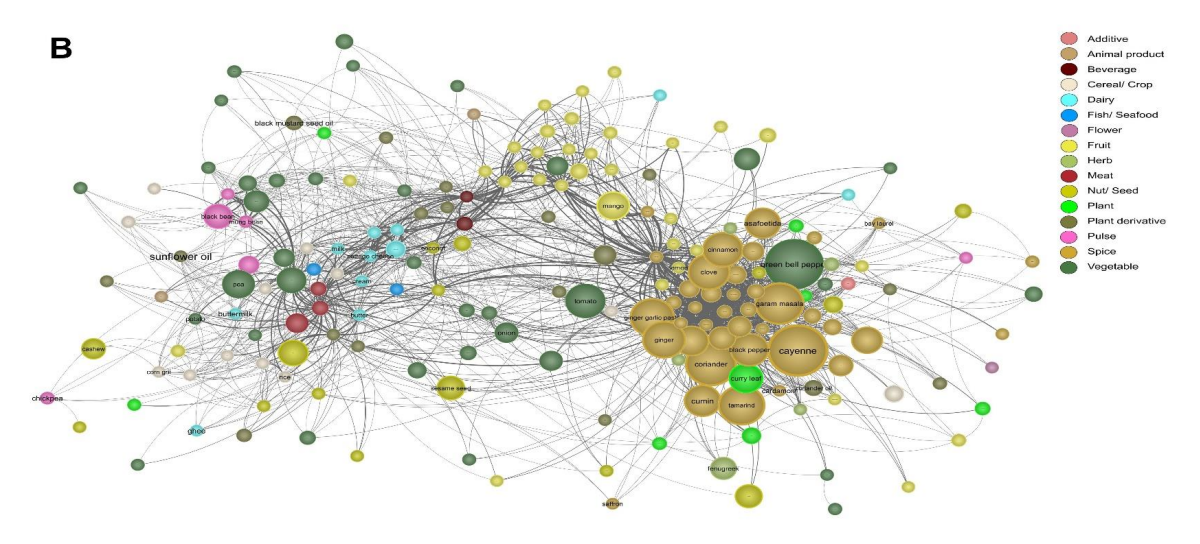Data Mining Indian Recipes Reveals New Food Pairing Phenomenon
The food pairing hypothesis is the idea that ingredients that share the same flavors ought to combine well in recipes. For example, the English chef Heston Blumenthal discovered that white chocolate and caviar share many flavors and turn out to be a good combination. Other unusual combinations that seem to confirm the hypothesis include strawberries and peas, asparagus and butter, and chocolate and blue cheese.

But in recent years researchers have begun to question how well this hypothesis holds in different cuisines. For example, food pairing seems to be common in North American and Western European cuisines but absent in cuisines from southern Europe and East Asia.
Today, Anupam Jain and pals at the Indian Institute of Technology Jodhpur say the opposite effect occurs in Indian cuisine. In this part of the world, foods with common flavors are less likely to appear together in the same recipe. And the presence of certain spices make the negative food pairing effect even stronger.
Jain and co began their work by downloading more than 2,500 recipes from an online cooking database called TarlaDalal.com. These recipes come from eight sub-cuisines, including Bengali, Gujarati, Punjabi, and South Indian, which together span vast geographies, climates, and cultures in the Indian subcontinent.
Together, these recipes contain 194 different ingredients. The average recipe contains seven ingredients but some can contain up to 40. In particular, the Mughlai sub-cuisine has many recipes with exceptionally large numbers of ingredients, probably because of its royal heritage.
Jain and co then created a flavor network in which ingredients are linked if they appear together in the same recipe. The network can then be studied for interesting phenomenon such as clustering effects.
The question that the team set out to answer was to what extent food pairing is positive or negative. In other words, do ingredients sharing flavor compounds occur in the same recipe more often than if the ingredients were chosen at random.
The results make for interesting reading. Jain and co conclude that Indian cuisine is characterized by strong negative food pairing. Not only that, but the strength of this negative correlation is much higher than anything previously reported.
They also found that specific ingredients dramatically effect food pairing. For example, the presence of cayenne pepper strongly biases the flavor sharing pattern of Indian cuisine towards negative pairing. Other ingredients that have a similar effect include green bell pepper, coriander, garam masala, tamarind, ginger, cinnamon and so on.
In other words, spices make the negative food pairing effect more powerful, a phenomenon never seen before. “Our study reveals that spices occupy a unique position in the ingredient composition of Indian cuisine and play a major role in defining its characteristic profile,” say Jain and co.
That result has some interesting corollaries. In many cuisines, spices add flavor but also prevent food spoilage by killing certain types of bacteria. Jain and co say this medicinal role must have had a significant effect on the way recipes evolved since removing these ingredients would have had health impacts. “We conclude that the evolution of cooking driven by medicinal beliefs would have left its signature on traditional Indian recipes,” they say.
The result also has implications for the future of food. In the same way that Western chefs search for unusual ingredients that share the same flavors, negative food pairing may also drive the development of new flavor combinations and recipes in Indian food. “Our study could potentially lead to methods for creating novel Indian signature recipes, healthy recipe alterations and recipe recommender systems,” conclude Jain and co.
Beyond that, this work shows how powerful network science has become in analyzing disparate aspects of everyday life. Treating recipes as networks has turned out to be a powerful tool that is changing the way we think about food and how we consume it.
Ref: arxiv.org/abs/1502.03815 : Spices Form The Basis Of Food Pairing In Indian Cuisine
Deep Dive
Artificial intelligence
Large language models can do jaw-dropping things. But nobody knows exactly why.
And that's a problem. Figuring it out is one of the biggest scientific puzzles of our time and a crucial step towards controlling more powerful future models.
Google DeepMind’s new generative model makes Super Mario–like games from scratch
Genie learns how to control games by watching hours and hours of video. It could help train next-gen robots too.
What’s next for generative video
OpenAI's Sora has raised the bar for AI moviemaking. Here are four things to bear in mind as we wrap our heads around what's coming.
Stay connected
Get the latest updates from
MIT Technology Review
Discover special offers, top stories, upcoming events, and more.